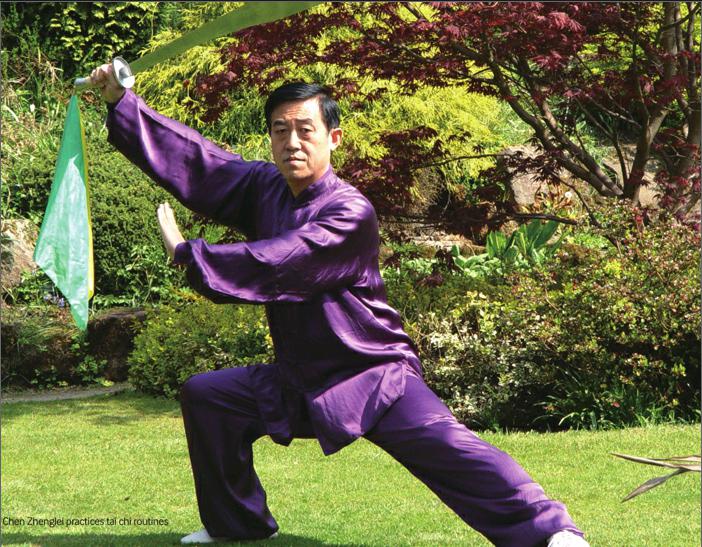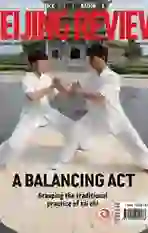NEVER TOO OLD TO EXER CISE
2017-06-22ByLiNan
By+Li+Nan

Stomps, punches and kicks. Many of James Healys movements are swift, powerful and explosive. Every time Healy, a 59-year-old American copy editor and an advanced student of Chen-style tai chi in Beijing, finishes his “tai chi break”—practicing tai chis essential 18 forms in his companys rose garden after long office hours, a dialogue is usually generated between Healy (H) and passers-by(P):
P: What is that?
H: Tai chi.
P: No, its not. You practice it fast.
H: Its the real tai chi.
Healys answers often surprise the questioners, most of whom are Chinese. “Even sometimes Chinese people dont understand the real tai chi… And people dont realize that tai chi is martial,” Healy told Beijing Review. His remarks came a month after a controversial “fight” between a self-proclaimed tai chi master and a mixed martial artist.
On April 27, the face-off between tai chi practitioner Wei Lei and mixed martial arts coach Xu Xiaodong had Chinas social media buzzing. Wei was knocked over 13 seconds after the fight began. Immediately thereafter, Xu claimed that “tai chi is a body building exercise rather than a martial art”and “99 percent of the tai chi exercised by practitioners is fake.” He said he intended to lift the veil shrouding “fake martial artists.”
The fight soon sparked a heated debate about what the real tai chi is and whether it is a fighting sport or a body-building exercise. Some question whether tai chi and other traditional martial arts, known broadly as wushu, are still as strong as have always been claimed by practitioners. In addition, some have put forward suggestions on how to promote traditional martial arts in the future.
To remain martial
Perceptions about tai chi are divided in China. Some regard it as a street bodybuilding exercise which is typified by slow movements and performed mostly by the elderly, whereas some consider it a mysterious and explosive martial art mastered by few talented practitioners. So what is authentic or traditional tai chi?
None of the perceptions paint a whole picture on the reality of tai chi, according to Chen Zhenglei, 68, a master of the Chenstyle tai chi from Chenjiagou Village, the cradle of tai chi, 75 km northeast of the Shaolin Temple in central Chinas Henan Province. The Chen-style tai chi, created in the early 17th century by Chen Wangting, is believed to be the origin of all the other popular tai chi schools, including the Yang,Wu, Wu (Hao), He and Sun styles. It was listed as one of the nations intangible cultural heritages in 2006.
As a lineal descendant to the hundreds-ofyears old Chen family, Chen started practicing tai chi when he was 8. He passed the ninthranking Chinese Wushu Duanwei exam, the highest national martial art evaluation and ranking system, run by the Chinese Wushu Association (CWA) in Beijing. In 1995, he was ranked as one of Chinas Top 10 Martial Artists by the CWA. At the age of 60, he was named one of the inheritors of the Chen-style tai chi.
“Tai chi definitely can fight. It is a martial art which was first created to combat invaders or enemies in the cold weapon era,”Chen told Beijing Review, adding that his ancestors were either generals or bodyguards. He noted that the fighting techniques of tai chi, including responses and self-defense drills, which require lots of hard training, are being gradually marginalized with the usage of firearms. More and more Chinese tend to practice tai chis basic and slow movements to keep fit.
Therefore, Chen divides tai chi practitioners into two groups: those who “play” slow tai chi forms for relaxation and enjoy the harmonic philosophy of the tai chi culture, and those who train hard for the martial skills. “Among hundreds of millions of tai chi practitioners, those who can fight make up only a small fraction, say 5 to 10 percent, and its not an easy task,”Chen said. “As a saying goes, it takes a tai chi practitioner 10 years to gain the ability to fight, whereas a monk in the Shaolin Temple takes three years,” he said.
Chinas boxing, according to Xiao Qin, Vice President of the Hainan Wushu Association in south China, can be roughly categorized into two schools: internal boxing like tai chi and external boxing like the Shaolin grouping. They adopt different training methodologies and require varied time spans.
“Tai chi aims to train flexibility, rather than hard strength,” Chen said, adding that tai chi focuses very much on the inside of the body to explore the internal arts, known as neigong, which include breathing, awareness exercises and meditation.
Tai chi practitioners, to be resilient and quick in fighting, have to go through three steps: practicing routines, pushing hands and sparring. Routines, known as taolu, help practitioners get to know their bodies and become resilient. Pushing hands, known as tuishou, helps to understand the rivals movements and how to evade direct attacks; while sparring, known as sanshou, helps to defend against attacks and counterattack with sudden and explosive hits. “Without at least 10 years of great effort, one cannot accomplish the three steps and be able to fight,” Chen said. By “great effort,” he means one should train for four to eight hours per day under the instruction of a professional coach. Only by this way can a tai chi practitioners movements be soft, quick and explosive.
Some say practicing tai chi also helps to improve ones martial art techniques learnt earlier. Healy is one of them. Before engaging himself with tai chi in 1985, he had a long experience in martial arts. He has a seconddegree black belt in Korean taekwondo and a brown belt in Okinawan Goju-Ryu Karate. Practicing tai chi helps him to further progress in martial arts. “The Chen-style tai chi trains a person to focus on the rotation of the body. All muscles are used. The rotation of the Chen-style tai chi makes those techniques [of taekwondo and Goju] more powerful,” Healy said.
Xiao echoed Healys view. Traditional Chinese martial arts consist of many basic fi ghting skills, especially kicks, which help to prepare practitioners for other martial arts, Xiao said.
Tai chi culture
Although admitting most of tai chi fans are“playing” tai chi, Chen denied the accusation that tai chi is a deceit. He believes that tai chi exercise is an integrated part of the tai chi culture, which features martial arts, health benefi ts and the philosophy of balance. In fact, tai chis health benefi ts have been proven.
As early as 2002, a study led by Dr. William Tsang from Hong Kong Polytechnic University found that tai Chi specifically improves the expansion and contraction of the arteries, an important indicator of the healthiness of the heart, and increases knee muscle strength. The fi ndings were published on the website of the Journal of Preventive Cardiology.
The fact that tai chi could be practiced anytime and anywhere without the constraints of equipment or venue has helped it gain global popularity in recent decades. The population of tai chi practitioners was estimated to be 300 million spreading over more than 150 countries and regions, according to a report published by Chinanews.com, a Beijing-based news portal, in 2011.
Tai chis added appeal also lies in its philosophy of balance between the yin and yang, which are typical of Confucianism and Taoism. Jack Ma, founder of Chinas leading e-commerce titan Alibaba Group and a big fan of tai chi, has established a tai chi cultural company, Taiji Zen, with Kungfu movie star Jet Li in Hangzhou, east Chinas Zhejiang Province, in 2011. In Taiji Zen, Ma offers tai chi philosophy classes for entrepreneurs at a price of 100,000 yuan ($14,500), explaining how to keep balance in business in a three-day class.
“Tai chi highlights the shift of the yin and yang as well as emptiness and fullness, couples stillness with movement, up and down… When a real tai chi master is practicing routines, pushing hands and sparring, he or she is not just exercising his or her body, but is also attempting to research the philosophy of tai chi again and again,” said Ma in a microblogging post after the “fight”between Xu and Wei.
Hurdles ahead
Although tai chi has gained widespread popularity as a spiritual breathing and balance exercise enjoyed by people of all ages, its martial function has been marginalized. “The martial part of tai chi has to be carried on by certain practitioners. If we all treat tai chi just as a body-building exercise, its authentic appeal will be eroded,” Chen said.
How to better promote tai chi and other traditional martial arts remains a problem for martial artists. “Standardization of every tai chi movement is one of the biggest challenges,”Chen Bin, son of Chen Zhenglei, told Beijing Review. He added that tai chi, as part of internal arts, boasts many vague concepts that are not easily clarifi ed by straightforward language and specific figures. “What we can do now is to standardize the training methods and the explanation and performance of the basic routines,”he said.
“Only by standardizing its training methods can tai chi further go global,” said Zhang Xingliang, President of Beijing-based Zhenglei Tai Chi Academy.
As tai chi is often seen performed in slow motion in a quiet park instead of a fi ght ring, few have the opportunity to view the martial facet of tai chi. Therefore, Healy suggested tai chi actively engage in a public relations campaign. Fortunately, the young-generation inheritors like Chen Bin have moved to use multimedia to promote the traditional martial art. Books in multiple languages have been published, while more videos and documentaries are being produced. “Opening up martial arts to the Englishspeaking world through books and videos is very good,” Healy said.
